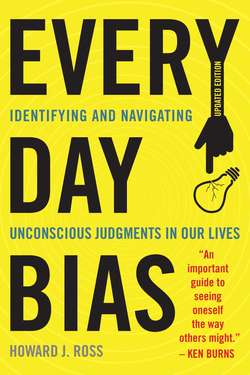Everyday Bias

Реклама. ООО «ЛитРес», ИНН: 7719571260.
Оглавление
Howard J. Ross. Everyday Bias
Acknowledgments
Introduction
If You Are Human, You Are Biased
Is There Only One Kind of Bias?
How Rational Are We?
Thinking about Thinking
The Many Faces of Bias
Life, Death, Arrests, and. Unconscious Bias
Who Has the Power?
Like Water for the Fish
The Legal System
The Health-Care System
Access
Politics
Shifting to Neutral
1. Recognizing that bias is a normal part of the human experience
2. Develop the capacity for self-observation
3. Practice constructive uncertainty
4. Explore awkwardness or discomfort
5. Engage with people in groups you may not know very well, or about whom you harbor biases
6. Get feedback and data
Incubators of Consciousness
Eight Great Questions to Ask. While Making Talent Decisions
1. Are there patterns of privilege or exclusion that are visible in your team or organization? (e.g., tall leaders, men in certain positions, people from certain countries, certain names?)
2. Is there any reason to suspect that the team making the recommendation might have bias that is motivated by self-interest?
3. Have we explored the broadest possible ranges of possibilities regarding the situation we are dealing with at that moment?
4. Check for groupthink: Were there dissenting opinions within the team and were they adequately explored?
5. Are the people who are making the recommendation inordinately enamored with it, or are people who are opposed to it surprisingly strongly opposed to it?
6. Is it possible that a similar person or experience from the past is unduly influencing your perception of the current person or situation?
7. Do you have all of the information you need to make the best decision?
8. Do you know where the information that you are using came from? Are you clear that it was from a dependable source? Are you clear about what it is proving?
Finding Success by Changing Systems at BAE Systems
Conclusion
Appendix. A Top Ten List of Ways to Identify and Navigate Bias in Talent Management
Recruitment
Sourcing
Interviewing
Hiring
Onboarding
Mentoring and Sponsorship
Performance Review/Employee Assessment
Calibration
Recognizing Talent
Developing and Promoting Talent
Bibliography
Index
About the Author
Отрывок из книги
A lot has happened in the world since the first printing of this book in 2014. I have had the opportunity to travel all over the world, meeting people in all walks of life and developing a deep appreciation of how bias impacts the lives of people in Tokyo, Japan; Stockholm, Sweden; Basel, Switzerland; Paris, France; Copenhagen, Denmark; New Delhi, India; London, England; Havana, Cuba; Bahia, Brazil; and San Juan, Puerto Rico, among countless other cities and countries. I have been present to the courage of people who made themselves vulnerable and shared their stories in dozens of states, and delivered workshops, seminars, and webinars to hundreds of thousands of people. Their humanity is a constant inspiration.
Of course, a lot has also happened in the world around us. Michael Brown was shot and killed in Ferguson, Missouri, one month after the book was originally released. His death was followed by dozens of other incidents of bias leading to horrific or fatal results. We have also seen the legalization of same gender marriage, both here in the United States and in other countries around the world; the Black Lives Matter Movement; the 2016 Presidential election; the #MeToo movement; Colin Kaepernick’s protest against police violence; the escalation of white supremacists, marching in Charlottesville, and the President’s reference to them as “very fine people”; Four congresswomen of color being told to “go back where you came from!”
.....
My intention in writing this book is not to wag the finger of self-
righteousness at you, the reader, or to act like this is something that I am immune to any more than anyone else. In fact, I am very clear that we are all, as human beings, in this boat together!
.....